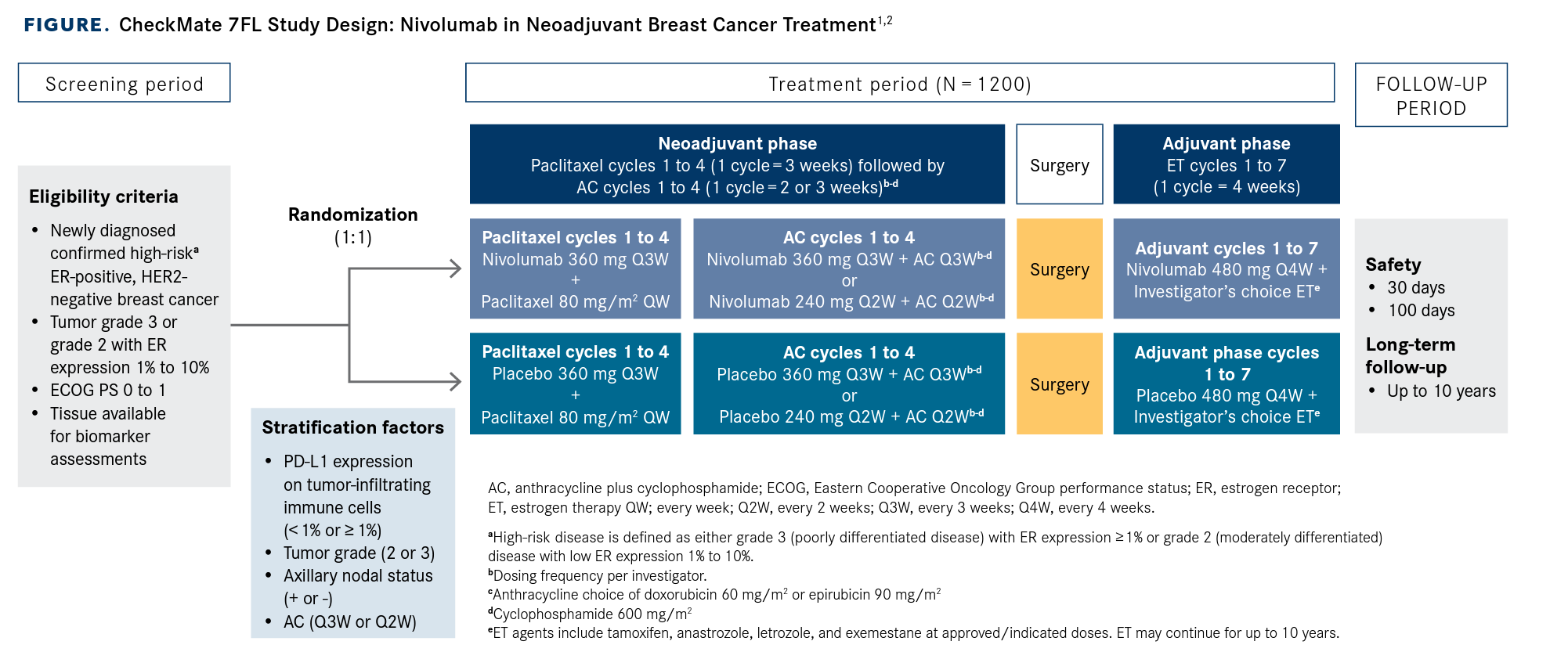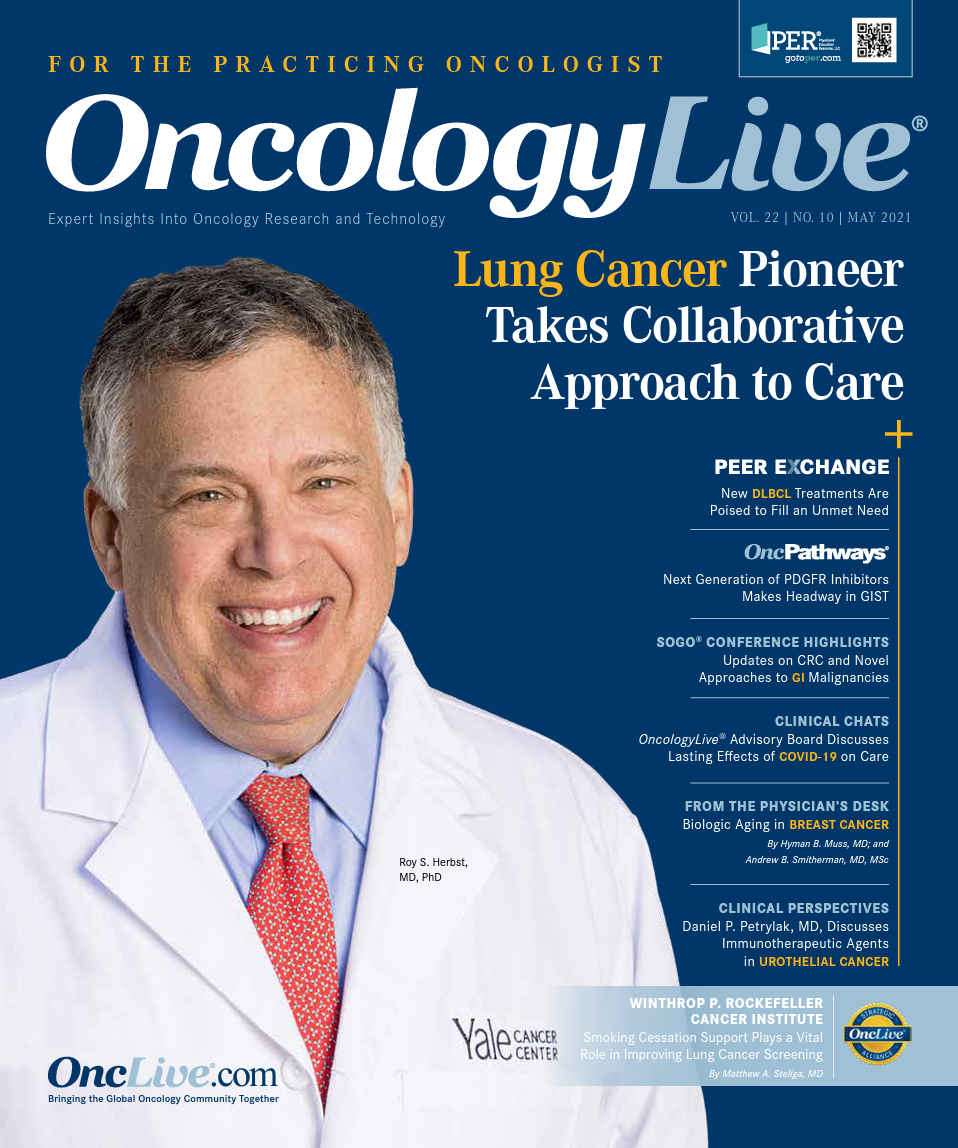Publication
Article
Oncology Live®
Long-Term Neoadjuvant Study Tests Nivolumab in ER+/HER2- Breast Cancer
Author(s):
Investigators are evaluating the addition of nivolumab to standard neoadjuvant therapy in patients with high-risk, estrogen-receptor–positive/ HER2-negative breast cancer to determine whether the PD-1 immune checkpoint inhibitor can improve recurrence rates.
Heather L. McArthur, MD, MPH

Investigators are evaluating the addition of nivolumab (Opdivo) to standard neoadjuvant therapy in patients with high-risk, estrogen-receptor (ER)–positive/ HER2-negative breast cancer to determine whether the PD-1 immune checkpoint inhibitor can improve recurrence rates. CheckMate 7FL (NCT04109066) is a large, long-term phase 3 trial comparing the efficacy of chemotherapy with either nivolumab or placebo in treatment-naive patients, followed by surgery and adjuvant therapy.1,2
The combination of PD-1 inhibition and chemotherapy has demonstrated promising response rates and antitumor activity across breast cancer subtypes in early clinical findings, investigators said.
The biology of ER-positive, HER2negative disease also suggests that the combination strategy may mitigate tumor inflammation and, therefore, resistance to endocrine therapy.2
“What we’ve learned from checkpoint blockade is that the earlier on you apply these strategies in the course of disease, the more likely they are to be effective,” Heather L. McArthur, MD, MPH, a leading investigator in the study, said in an interview with OncologyLive®.
“Given the success that we’ve seen in triple-negative disease, with a signal that we are actually improving cure rates with these types of strategies, makes me very excited about this approach.”
Findings from the I-SPY 2 trial (NCT01042379) showed that adding a checkpoint inhibitor to neoadjuvant chemotherapy prior to surgery could improve pathologic complete response (pCR) rates, said McArthur, medical director of breast oncology at Samuel Oschin Comprehensive Cancer Center, Cedars-Sinai Medical Center in Los Angeles, California. The I-SPY trials are designed to rapidly screen promising experimental treatments and identify those most effective in specific patient subgroups based on biomarker signatures.
“Historically, it has been very difficult to improve pCR for ER-positive disease. Many of us were very excited to see the I-SPY 2 data and to see that magnitude of impact on estimated pCR because that was really unprecedented. This generated a lot of enthusiasm for these large phase 3 studies,” McArthur said.
An interim analysis of I-SPY 2 results released in February 2020 found that estimated pCR rates had more than doubled for patients who received pembrolizumab (Keytruda), a PD-1 inhibitor, plus chemotherapy (n = 69) vs standard neoadjuvant chemotherapy (n = 181).
The pCR rates were 44% for patients who were HER2 negative, 30% for those with hormone receptor–positive/HER2-negative disease, and 60% for those with triple-negative breast cancer (TNBC) compared with 17%, 13%, and 22%, respectively, with standard chemotherapy.3
Moreover, I-SPY 2 investigators said achieving a pCR appeared predictive of longterm benefit. Patients who reached pCR following pembrolizumab plus chemotherapy had a 93% event-free survival (EFS) rate at 3 years with 2.8 years’ median follow-up.
There was a 99% predictive probability that pembrolizumab plus neoadjuvant chemotherapy resulted in significantly better outcomes than chemotherapy alone in a phase 3 randomized clinical trial in patients with HER2negative breast cancer.
Investigators anticipate that nivolumab would perform similarly to pembrolizumab in this patient population, according to McArthur. “They seem to be comparable in other disease types such as metastatic melanoma, for example. There is no reason to suggest that there would be any significant meaningful differences between the strategies.”
McArthur said clinical experience with nivolumab in breast cancer is limited, but that findings from at least one study suggest the agent can be effectively combined with chemotherapy. In the phase 2 TONIC trial (NCT02499367), nivolumab with or without have a new diagnosis of high-risk HER2negative breast cancer, defined as either grade 3 (poorly differentiated) with ER expression of 1% or greater or grade 2 (moderately differentiated) with low ER expression of 1% to 10%. Participants must have confirmed locally invasive breast ductal carcinoma char“What we’ve learned from checkpoint blockade is that the earlier you apply these strategies, the more likely they are to be effective.” acterized as either T1c-T2 (tumor size, ≥ 2 cm), clinical node (cN) stage 1 to cN2, or T3-T4, cN0-cN2 (FIGURE).1,2 The trial is open to patients regardless of PD-L1 expression status but findings will be stratified based on the biomarker (< 1% or ≥ 1%). “As a community, we are very interested in identifying markers that predict a response and for toxicity,” McArthur said. “PD-L1 has been the most helpful biomarker so far in triple-negative disease. This is not required for enrollment in the study, but it is a stratification factor and will be interrogated retrospectively in relationship to clinical responses.” Patients will also be stratified by axillary nodal status (positive or negative), tumor grade (2 or 3), and anthracycline plus cyclophosphamide schedule (every 3 weeks or every 2 weeks). various induction therapies including chemotherapy demonstrated objective response rates (ORR) ranging from 17% to 35%, depending upon the cohort, in patients with metastatic TNBC.4
FIGURE. CheckMate 7FL Study Design: Nivolumab in Neoadjuvant Breast Cancer Treatment1,2

Ultimately, McArthur said, her hope for patients with breast cancer is “that with rational biologic strategies, we will actually be able to minimize the amount of cytotoxic therapy that we ultimately need to administer to achieve cure. The majority of the toxicity with these regimens comes from the chemotherapy backbone.”
CHECKMATE 7FL Study Details
In CheckMate 7FL, investigators are seeking to recruit 1200 patients at 225 sites in 25 countries. To be eligible, patients must have a new diagnosis of high-risk HER2negative breast cancer, defined as either grade 3 (poorly differentiated) with ER expression of 1% or greater or grade 2 (moderately differentiated) with low ER expression of 1% to 10%. Participants must have confirmed locally invasive breast ductal carcinoma characterized as either T1c-T2 (tumor size, ≥ 2 cm), clinical node (cN) stage 1 to cN2, or T3-T4, cN0-cN2 (FIGURE).1,2
The trial is open to patients regardless of PD-L1 expression status but findings will be stratified based on the biomarker (< 1% or ≥ 1%).
“As a community, we are very interested in identifying markers that predict a response and for toxicity,” McArthur said. “PD-L1 has been the most helpful biomarker so far in triple-negative disease. This is not required for enrollment in the study, but it is a stratification factor and will be interrogated retrospectively in relationship to clinical responses.”
Patients will also be stratified by axillary nodal status (positive or negative), tumor grade (2 or 3), and anthracycline plus cyclophosphamide schedule (every 3 weeks or every 2 weeks).
The primary end points are pCR, defined as no invasive residual disease in breast and lymph nodes (ypT0/is, ypN0), and EFS, defined as the time from randomization to disease progression.
Secondary end points include overall survival, disease-free survival, distant metastasis-free survival, overall response rate, safety and tolerability, and quality of life and physical functioning.
CheckMate 7FL is a long-term study with an estimated completion date of June 20, 2032. “A phase 3 study with a coprimary end point of EFS typically has to be on the longer side,” McArthur noted. “More follow-up is needed because, with ER–positive disease, recurrences can happen late, which is different from triple-negative disease where recurrences typically occur within 2 to 3 years.”
In the neoadjuvant phase of the study, patients will receive 8 cycles of treatment, consisting of 4 cycles with nivolumab 360 mg or placebo every 3 weeks plus weekly paclitaxel at 80 mg/m2, then 4 cycles of nivolumab at either 360 mg every 3 weeks or 240 mg every 2 weeks plus anthracycline and cyclophosphamide.
After surgery, patients will receive up to 7 cycles (every 4 weeks) of adjuvant treatment with nivolumab 480 mg or placebo in combination with investigator’s choice of endocrine therapy, including tamoxifen, anastrozole, letrozole, or exemestane at approved doses.
Another Novel Combination
Investigators are also studying nivolumab in the neoadjuvant setting in combination with palbociclib (Ibrance), a CDK4/6 inhibitor, and ER-targeted therapy in postmenopausal women and men with ER-positive/HER2negative primary breast cancer in the phase 2 CheckMate 7A8 study (NCT04075604).
Patients will receive nivolumab plus palbociclib and anastrozole during a safety run-in phase and will then be randomized to 1 of 3 treatment groups. Arms A and B will test the 3-drug combination on 2 different schedules and arm C will evaluate palbociclib plus anastrozole.5
Investigators are seeking to recruit 136 patients at 66 worldwide trial sites. Patients will be stratified by PD-L1 expression, node status, and tumor size. Following treatment, all patients will undergo surgery and safety follow-up.
Primary end points are number of patients with occurrence of dose-limiting toxicity in the safety run-in phase and the residual cancer burden rate at time of surgery in the randomized phase.
Secondary end points include safety and tolerability, pCR rate, ORR, and breast- conserving surgery rate.
References
- Study of nivolumab versus placebo in combination with neoadjuvant chemotherapy and adjuvant endocrine therapy in participants with high-risk, estrogen receptor-positive (ER+), human epidermal growth factor receptor 2-negative (HER2-) primary breast cancer (CheckMate 7FL). ClinicalTrials.gov. Updated January 12, 2021. Accessed April 16, 2021. https://clinicaltrials.gov/ct2/show/NCT04109066
- Loi S, McArthur HL, Harbeck N, et al. A phase III trial of nivolumab with neoadjuvant chemotherapy and adjuvant endocrine therapy in ER+/HER2–primary breast cancer: CheckMate 7FL. J Clin Oncol. 2020;38(suppl 15):TPS604. doi:10.1200/JCO.2020.38.15_suppl.TPS604
- Nanda R, Liu MC, Yau C, et al. Effect of pembrolizumab plus neoadjuvant chemotherapy on pathologic complete response in women with early-stage breast cancer: an analysis of the ongoing phase 2 adaptively randomized I-SPY2 trial. JAMA Oncol. 2020;6(5):676-684. doi:10.1001/jamaoncol.2019.6650
- Voorwerk L, Slagter M, Horlings HM, et al. Immune induction strategies in metastatic triple-negative breast cancer to enhance the sensitivity to PD-1 blockade: the TONIC trial. Nat Med. 2019; 25(6):920-928. doi:10.1038/s41591-019-0432-4
- Tolaney SM, Jerusalem G, Salgado R, et al. A phase II trial of nivolumab (NIVO) + palbociclib (PAL) + anastrozole (ANA) in postmenopausal women and men with estrogen receptor (ER)+/human epidermal growth factor 2 (HER2)–primary breast cancer (BC): CheckMate 7A8. J Clin Oncol. 2020;38(suppl 15):TPS1105. doi:10.1200/JCO.2020.38.15_suppl.TPS1105










